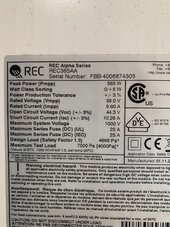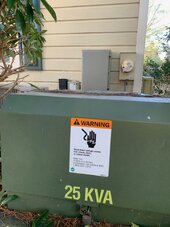Do they not have the equivalent of what we call Rule21 in California, which is the full set of utility regulations? AFAICT there should be existing non solar cases that are regulated, for instance backup generators that are always spinning in idle, running parallel to grid. Or on-site cogeneration power plants.
I don't know I will look into it thoroughly though. Lots of Generacs here, that's for sure. The anti-solar attitude is, well... interesting, to say the least, and , around here, the less I say about and focus on that attitude, the better! Safety of electric crews is of course a totally legitimate concern
The service disconnect is often your first breaker past the meter. It is where the N-G bond is made. Anyway it doesn’t, the service disconnect, as long as it is able to see the full load that you want to offset, such that increased output from the hybrid will reduce the reading.
"...as long as it is able to see the full load that you want to offset, such that increased output from the hybrid will reduce the reading."
Right. And I want to be able to have the solar panels/batteries connected to power every load I have, all 4 HVAC systems, pumps, shops, greenhouses, etc. Basically everything off my main breaker. And IF I choose to disconnect from the grid completely sometimes, it will be up to me not to turn on every HVAC system, etc., at the same time. Thoughts?
That order sounds about right, I’ve unfortunately forgotten the full context of the thread.
I think I got the order wrong. Of course I will ultimately have a professional consultant/installer on site review and sign off on the work, but I need to and would like to understand.
I actually can't readily conceptualize how the hybrid ties into a grid tie system I envision where I never give power back to the grid, but the grid is there for me when I need it/want as a supplement or substitute. I just can't see it.
Furthermore, and possibly more complicating, like I said, I'd like to be able to physically cut off the grid power, whenever I want. I know I can change the setting on the hybrid so it takes no power from the grid, but a physical switch sounds appealing to be sure about actually being off grid.
But back to my main confusion: for my envisioned "grid tie," how can the hybrid charger/inverter be placed anywhere except between the utility's power meter at my house and my house's transformer? So, it must be
upstream of the utility meter, and
downstream of the house transformer, right? See attached pic, the transformer says 25 KWA, and there's plenty of room b/w it and the meter. The old Generac propane hog at the house is 34 kw, I'm pretty sure. It was here when I moved in.
=======
Imaging a situation where there is a ring of fluffy bright clouds at a distance. This can boost the output of a single array pretty high since sun is coming from more angles. This also helps the different oriented arrays
It's interesting, and I'm glad to know about having sub-arrays going to separate mppt inputs on the hybrid, or just one mppt input with some strings with different orientations. I was aware of "clipping" in audio recording, but before this forum made me aware of it in the solar context, I thought it would be a great benefit to have panels placed right beside and due north a large lake or body of water so that the intense reflection in winter of the low sun bouncing off the often smooth as glass water into the solar panels would nearly DOUBLE the amount of light reaching at times. But this seems in fact a terrible liability! It appears to make it extremely difficult to size the system properly, and use panels economically! I am indeed on the water, but I can place the solar panels far enough away from the water to avoid this. I previously wished I had enough room to place them on the water for this very reason! I was planning on putting my two trailers to be covered with solar panels on the water. Yikes! RVers must have a hard time with this in winter, right on the water. I wonder if a lot of these RVers' systems get overloaded?
Thank you so much zany and the forum. What a great resource. I've wanted solar/wind since I started RVing around 2000. True off-grid independence potential. The dream is finally starting to materialize (I took delivery today of 16 LiTime LiFePO4 230ah today! 54 REC365AAs on the way and I have ten already.)
I started watching Will's videos occasionally several years ago. He explains things so well for novices like me, and he really breaks things down (sometimes literally!). But it's his personality that makes him is the best ambassador for solar imaginable. I got a still-boxed 24k BTU EG4HybridAC/DCSolarMiniSplit because of him, and plan to get more eventually, and same goes for LiTime LiFePO4. I know he has affiliations with some of these products, and I do my own homework, just like I'm doing here with the EG418KPV, but I've gotta say I just trust this guy, and that's really not something I say often in a business context. An example of my homework is something I've become aware of that, if true, is potentially important in the marine context. Evidently, lithium batteries above 100-200ah should NEVER be used on boats that will ever be in rough water, even big yachts. And 100ah is much preferable! It's a matter of the cells losing physical integrity and structrual strength as the size of the cells are scaled up. I was aware of this possibility when I pulled the trigger on the 16 LiTime 230ah, for home and RV/trailer use, but I plan for a battery bank of 100 ah batteries for the marine purpose. And EG4 had their 100ah batteries of sale a few weeks ago for about $235 each! But I think the LiTime LiFePO4 100ah trolling batteries are even better for this purpose. I think Will does too, but that's conjecture. He's says he's never see such surge power. Thanks forum!




